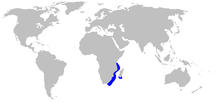African angel shark
| African angel shark | ||||||||||||
|---|---|---|---|---|---|---|---|---|---|---|---|---|
| Systematics | ||||||||||||
|
||||||||||||
| Scientific name | ||||||||||||
| Squatina africana | ||||||||||||
| Regan , 1908 |
The African angel shark ( Squatina africana ) is an angel shark up to 120 centimeters long . It occurs in the coastal area of East Africa.
Appearance and characteristics
The African angel shark can reach a maximum body length of about 120 cm. As with other angel sharks, the body is strongly flattened with very broad pectoral fins , which makes the animals look more like long rays in shape . However, the pectoral fins are clearly separated from the trunk, while in most rays they merge seamlessly into the body. They have two dorsal fins and no anal fin . The body has a gray to red-brown back color with numerous light and dark spots. There are also large dark bands or saddle spots on the large, triangular pectoral fins . The base of the tail is dark, the borders light. On the head there are large thorns concave from the eyes over the mouth.
The eyes are on the top of the head, the mouth is terminal, the outer nostrils are provided with short barbels . The injection holes are large, the number of lateral gill openings is five. The nasal flaps are simple.
distribution
The distribution area of the African angel shark is in the coastal area of East Africa and extends from South Africa to Mozambique to Tanzania (possibly also Somalia ) and to the southern tip of the island of Madagascar .
It lives in the outer edge area of the continental shelf mainly at depths between 60 and 300 meters (maximum depth 500 meters), whereby it occurs mainly on sandy and muddy subsoil.
Way of life
The African angel shark feeds primarily on small bony fish, cephalopods and crustaceans , which it prey on lying on the ground as a lurker . Like all angel sharks, it is ovoviviparous - the eggs are hatched in the mother before the young are born alive. The females of this species give birth to seven to eleven young animals. The animals reach sexual maturity with a body length of about 80 centimeters for the males and about 90 centimeters for the females.
Danger
The International Union for Conservation of Nature (IUCN) does not classify this type of endangerment due to insufficient data (“data deficient”). By-catch figures are only available for the South African region of KwaZulu-Natal .
supporting documents
- ↑ a b Squatina africana in the endangered Red List species the IUCN 2010 Posted by: Cliff, G. (SSG Subequatorial Africa Regional Workshop, September 2003), 2004. Retrieved on December 17 of 2010.
literature
- Leonard Compagno , Marc Dando, Sarah Fowler: Sharks of the World . Princeton University Press , Princeton and Oxford 2005, p. 138 ISBN 978-0-691-12072-0
